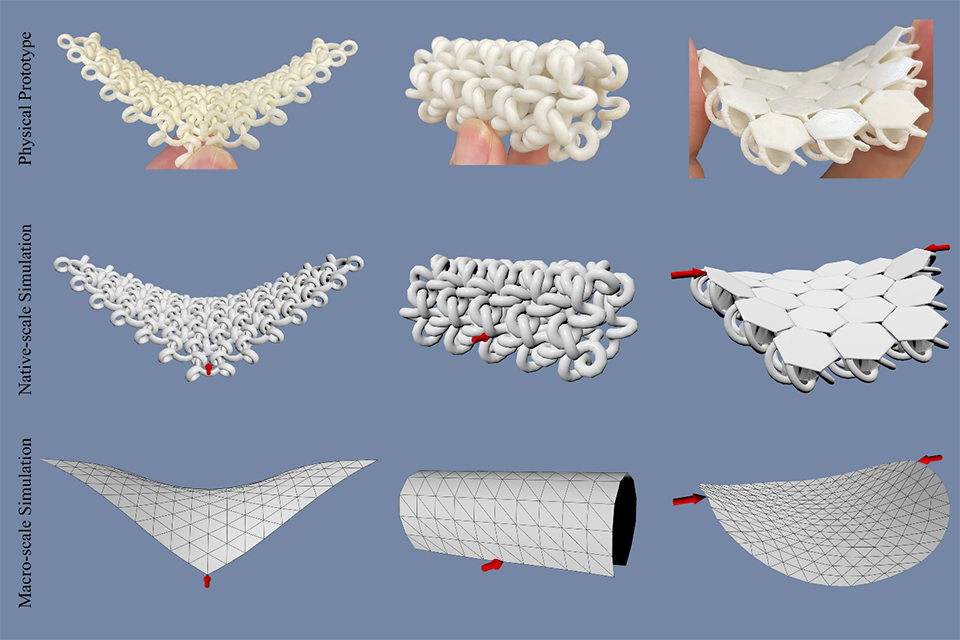Linked and Characterized
Medieval chainmail armor, small metal rings linked together in a pattern to form a mesh, have been used for thousands of years as protective gear for soldiers in battle. Picture a knight in their metal “suit” wearing chainmail armor as an additional layer of protection. Fast forward to the wide landscape of materials and fabrics in the modern era and chainmail-like materials remain a physical structure that is challenging to computationally represent, accounting for all of its unique mechanical properties.
An international team of researchers from ETH Zürich in Switzerland and Université de Montréal in Canada draws inspiration from medieval chainmail armor, generalizing it to the concept of discrete interlocking materials, or DIM.
“These materials possess remarkable flexibility, allowing them to adapt to necessary shapes, while also demonstrating impressive strength beyond a certain range of deformation,” says Pengbin Tang, the lead author of the research and PhD student advised by Bernhard Thomaszewski, a senior scientist at ETH Zürich and adjunct professor at the Université de Montréal.
“These unique properties make DIM attractive in robotics, orthotics, sportswear and many other areas of application,” adds Stelian Coros, collaborator and head of the computational robotics lab (CRL) at ETH Zürich.

Discrete Interlocking Materials are governed by strongly coupled, highly anisotropic, and asymmetric deformation limits. New method is able to capture and reproduce these effects for many types of interlocking materials. Using native-scale simulations as a basis, the researchers construct macro-mechanical deformation limits on bending and stretching which they use to develop an efficient macro-scale simulation model. “Beyond Chainmail: Computational Modeling of Discrete Interlocking Materials” © 2023 Tang, Coros, Thomaszewski
The researchers have developed a method for computational modeling, mechanical characterization, and macro-scale simulation of these 3D-printed chainmail fabrics made of quasi-rigid interlocking elements (the connectivity of rings or links in chainmail-like material).
A key challenge the new method addresses is accurately representing the deformation limits the quasi-rigid fabric exhibits when it bends and folds and adopts different shapes. Unlike conventional elastic materials, the mechanics of DIM are governed by contacts between individual elements. Their particular structure leads to extremely high contrast in deformation resistance. To obtain the deformation limits from a given DIM, the researchers’ developed a computational approach involving thousands of virtual deformation tests across the entire deformation space.
The novel method offers an intuitive, systematic way for macro-mechanical characterization which can pave the way to using DIM for garment design, note the researchers. Their analysis has largely focused on kinematic motion and, consequently, doesn’t consider friction nor elastic deformations in the structure. In future work, an extension of their macro-scale model could account for internal friction to simulate friction-dominated scenarios as well as explore geometric detail at the element level, which may be important for additional applications.
Pengbin Tang is excited to present this work at SIGGRAPH 2023. View the paper and video on the team page.
Each year, the SIGGRAPH Technical Papers program spans research areas from animation, simulation, and imaging to geometry, modeling, human-computer interaction, fabrication, robotics, and more. Visit the SIGGRAPH 2023 website to learn more about the program and for registration details.
###
Media Contact:
SIGGRAPH 2023 Marketing & Media Office
Email Contact
About ACM, ACM SIGGRAPH, and SIGGRAPH 2023
ACM, the Association for Computing Machinery, is the world’s largest educational and scientific computing society, uniting educators, researchers, and professionals to inspire dialogue, share resources, and address the field’s challenges. ACM SIGGRAPH is a special interest group within ACM that serves as an interdisciplinary community for members in research, technology, and applications in computer graphics and interactive techniques. The SIGGRAPH conference is the world’s leading annual interdisciplinary educational experience showcasing the latest in computer graphics and interactive techniques. SIGGRAPH 2023, the 50th annual conference hosted by ACM SIGGRAPH, will take place live 6–10 August at the Los Angeles Convention Center, along with a virtual access option.








